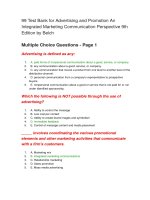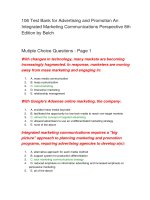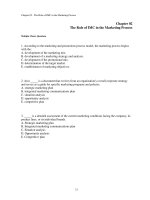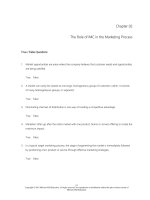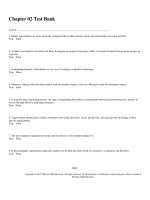Lecture Advertising and promotion: An integrated marketing communications perspective (10/e): Chapter 2 - George E. Belch, Michael A. Belch
Bạn đang xem bản rút gọn của tài liệu. Xem và tải ngay bản đầy đủ của tài liệu tại đây (786.41 KB, 16 trang )
Chapter 2
The Role of
IMC in the
Marketing
Process
Copyright © 2015 McGraw-Hill Education. All rights reserved. No reproduction or distribution without the prior written consent of
McGraw-Hill Education.
Figure 2.1 Marketing and Promotions
Process Model
Copyright © 2015 McGraw-Hill Education. All rights reserved. No reproduction or distribution without the prior written consent of
McGraw-Hill Education.
2
Marketing Strategy and Analysis
Copyright © 2015 McGraw-Hill Education. All rights reserved. No reproduction or distribution without the prior written consent of
McGraw-Hill Education.
3
Figure 2.2 The Target Marketing
Process
Copyright © 2015 McGraw-Hill Education. All rights reserved. No reproduction or distribution without the prior written consent of
McGraw-Hill Education.
4
Market Segmentation
Dividing a market into distinct groups with common
needs, who respond similarly to a marketing situation
Criteria
Geographic segmentation: Markets are divided into
different geographic units
Demographic segmentation: Dividing the market on
the basis age, sex, family size, education, income, and
social class
Psychographic segmentation: Dividing the market on
the basis of personality, lifecycles, and/or lifestyles
Copyright © 2015 McGraw-Hill Education. All rights reserved. No reproduction or distribution without the prior written consent of
McGraw-Hill Education.
5
Bases for Market Segmentation
Behavioristic segmentation
• Dividing consumers into groups according to
their usage, loyalties, or buying responses to
a product
• 80-20 rule: 20 percent of buyers account for
80 percent of sales volume
Benefit segmentation
• Grouping of consumers on the basis of
attributes sought in a product
Copyright © 2015 McGraw-Hill Education. All rights reserved. No reproduction or distribution without the prior written consent of
McGraw-Hill Education.
6
Selecting Target Market
Determine how many segments to
enter
Determine which segments offer
the most potential
Copyright © 2015 McGraw-Hill Education. All rights reserved. No reproduction or distribution without the prior written consent of
McGraw-Hill Education.
7
Market Coverage Alternatives
Undifferentiated marketing
• Ignoring segment differences and offering just one product
or service to the entire market
Differentiated marketing
• Involves marketing in a number of segments, developing
separate marketing strategies for each
Concentrated marketing
• Selecting a segment and attempting to capture a large
share of this market
Copyright © 2015 McGraw-Hill Education. All rights reserved. No reproduction or distribution without the prior written consent of
McGraw-Hill Education.
8
Positioning Strategies
Copyright © 2015 McGraw-Hill Education. All rights reserved. No reproduction or distribution without the prior written consent of
McGraw-Hill Education.
9
Repositioning
Altering a product’s or brand’s position due to:
Declining or stagnant sales
Anticipated opportunities in other market positions
Difficult to accomplish because of entrenched
perceptions and attitudes toward the product or
brand
Copyright © 2015 McGraw-Hill Education. All rights reserved. No reproduction or distribution without the prior written consent of
10
McGraw-Hill Education.
Product Decisions
Product symbolism: Refers to:
What a product or brand means to consumers
What consumers experience in purchasing and using a
product
Branding
Building and maintaining a favorable identity of the
company and its products
Packaging
Provides functional benefits such as economy,
protection, and storage
Copyright © 2015 McGraw-Hill Education. All rights reserved. No reproduction or distribution without the prior written consent of
11
McGraw-Hill Education.
Branding
Builds and maintains brand awareness and interest
Develops and enhances attitudes toward the company or
product
Builds relationships between the consumer and the brand
Brand identity: Combination of name, logo, symbols,
design, packaging, and image of associations held by
consumers
Brand equity: Intangible asset of added value
Copyright © 2015 McGraw-Hill Education. All rights reserved. No reproduction or distribution without the prior written consent of
12
McGraw-Hill Education.
Price Decisions
Price variable Refers to what the consumer has to
give in exchange for a purchase
Factors that determine price
Costs
Demand factors
Competition
Perceived value
Product quality
Advertising
Copyright © 2015 McGraw-Hill Education. All rights reserved. No reproduction or distribution without the prior written consent of
13
McGraw-Hill Education.
Marketing Channels
Interdependent organizations involved in making a
product or service available for use
Direct channels: Directly deal with customers
Driven by directresponse ads, telemarketing, the
Internet
Used when selling expensive and complex products
Indirect channels: Network of wholesalers and/or
retailers
Copyright © 2015 McGraw-Hill Education. All rights reserved. No reproduction or distribution without the prior written consent of
14
McGraw-Hill Education.
Promotional Push Strategies
Programs designed to persuade the trade to stock,
merchandise and promote a manufacturer’s
products
Goal
Push the product through the channels of
distribution by selling and promoting it
Trade advertising: Used to motivate wholesalers
and retailers to purchase products for resale
Copyright © 2015 McGraw-Hill Education. All rights reserved. No reproduction or distribution without the prior written consent of
15
McGraw-Hill Education.
Promotional Pull Strategies
Spending money on advertising and sales
promotion efforts directed toward the ultimate
consumer
Goal
Create demand among consumers
Encourage consumers to request the product from
the retailer
Copyright © 2015 McGraw-Hill Education. All rights reserved. No reproduction or distribution without the prior written consent of
16
McGraw-Hill Education.

